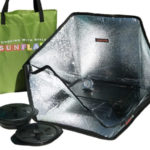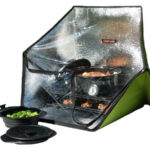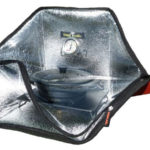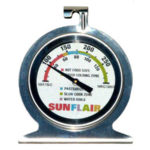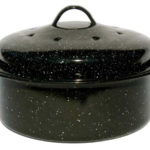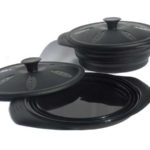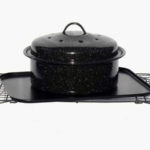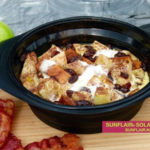Sunflair Solar Oven Review
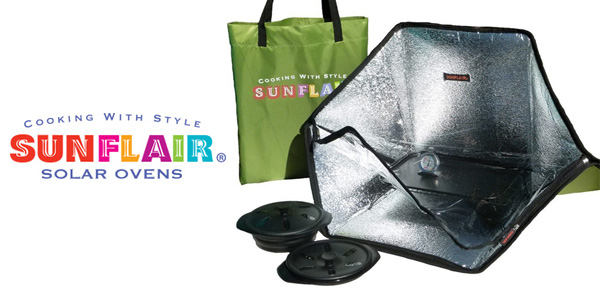 I was very curious about the Sunflair Solar Oven because of the unique way it breaks down to be small and very portable. Of all the ovens I tested, the Sunflair Solar Oven was the most portable, and the easiest to move and store. Additionally, it was the least expensive, but that isn’t to say it was cheap. It was well made and recognizing it for what it is, I think people will consider this a good option.
I was very curious about the Sunflair Solar Oven because of the unique way it breaks down to be small and very portable. Of all the ovens I tested, the Sunflair Solar Oven was the most portable, and the easiest to move and store. Additionally, it was the least expensive, but that isn’t to say it was cheap. It was well made and recognizing it for what it is, I think people will consider this a good option.
Price: $89-$164.99
Sunflair Solar Oven Specs
| Brand | Price | Size | Capacity | Stored Size | Carrying Case |
|---|---|---|---|---|---|
| Sunflair | $89-$165 | 19x16x18 without reflector | Medium | 16x2x19 | Yes, included |
| Ease of Use | Durability | Heat Potential | Cooking Speed | Packaging | Portability | Accessories |
|---|---|---|---|---|---|---|
| Sunflair |
Who is this solar oven for?
The Sunflair Solar Oven is great for people who are very mobile, as well as for those who need to consider storage space. It packs up quite small, so it’s easily moved. I would also suggest the Sunflair for those who want to try out solar ovens to see if they enjoy cooking with the sun. The Sunflair is a great gift as well.
How this solar oven cooked:
This solar oven was firmly in the middle of the pack when it came to cooking time and temperature. It has a good-sized cooking chamber, so you can cook more than some of the other solar ovens. I would say while this isn’t the fastest or fanciest solar oven, I’d still highly recommend it for its portability, packability, and price. Even though I own plenty of other solar ovens (no seriously…my tiny house is currently stacked to the ceiling with them!), my hand wanders to this one often and I think it might make an appearance under the Christmas tree for friends and family.
What I liked about this solar oven:
Size and weight. Hands down the Sunflair was the smallest oven when packed up and it’s super light. The case is nice and sturdy. While the Sunflair Solar Oven body is made of fabric, they executed this product well.
What I didn’t link about this solar oven:
I wish the main zipper for the clear front cover was much stronger and more of a heavy-duty-type zipper. The current zipper is okay, but not great, for an additional dollar’s worth of materials it could easily be upgraded.
Sunflair Solar Oven Photos
My Interview with the Sunflair Solar Oven Manufacturer
Can you give a quick rundown of your company and who you are?
At Sunflair, we make highly portable, lightweight solar ovens and accessories.
What is the background or story of the design of this solar oven?
Sunflair was recession-born after our family oven failed, and we couldn’t afford to fix it. I’ve always been an outdoor enthusiast from mountains and deserts to gardening in the yard and everything in between. I started cooking with the sun, and the food tasted fantastic. It was really a win, win, win on saving energy, the environment, and healthy eating. I thought this is something everyone can really enjoy and benefit from. Being a freelance toy designer, I wanted an oven that was easy to use and for them to be complete kits to take away the guesswork for people who were new to cooking with the sun. I wanted it to be lightweight, fold small, and be easy to open and close. It had to be front loading and allow for tiered cooking. And it even floats!
Who is the oven for and who isn’t it for?
Its intended for anyone who eats. It is designed for the patio, camping, tailgating, boating, fishing, hunting, emergency preparedness… We wanted it to be as versatile as possible.
What is one tip you could share about getting the most out of your solar cooker?
To understand cooking temperatures. The hottest place in the oven/cooker is the center core, where the pot sits. The thermometer is an approximate gage. A stovetop doesn’t exceed 212F. A simmer is 180-190F. A Dutch oven and slow cooker is 180-300. A Sunflair is in the exact temperature range.
When people have trouble cooking in your oven, what advice do you offer most often?
There are two. First, sometimes people try to grill or use the ovens like a microwave. Or they become hovering “pot-peekers” which releases energy. They basically overthink it when it’s really very simple: Put food in a pot, cover, and go do fun things. The food doesn’t burn because there isn’t a flame.
Second, the cover can steam up if not using a lid/cover, which blocks the sun’s rays from entering, and results in lower temperatures. To prevent steaming, cook 98% of dishes with a lid/cover just like a Dutch oven or slow cooker. Or unzip to a sweet spot to release the steam. It will be like a tea kettle. Energy in, steam out.
Reducing the amount of liquid in traditional kitchen recipes by 1/3-1/2 will speed up cooking. This is because traditional recipes add a lot more of liquid to compensate for the dry heat of a kitchen oven. Sunflair retains moisture, which also retains flavor.
What’s your favorite recipe or dish to cook in your oven?
Tough question, there’s a lot of favorites. The food is so yummy!! But what I find myself making most often is vegetable soup, a whole chicken about once a week which is made into many other dishes, salads, and sandwiches throughout the week. Quinoa is another food that will be turned into salads and side dishes for the coming weeks. It makes life easy.

